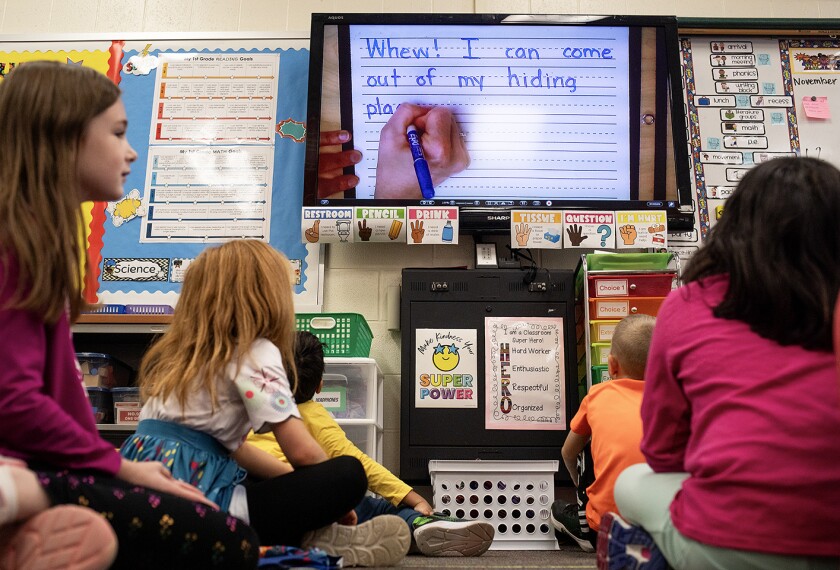In the midst of International Education Week, delegations from nearly half the states gathered here to devise strategies and seek advice on incorporating global studies into their curricula.
Billed as the States Institute on International Education in the Schools, the three-day affair brought together educators, policymakers, and representatives from the business and philanthropy worlds to find ways to close the “international knowledge gap” that experts say threatens America’s economy and security.
The National Governors Association, the Council of Chief State School Officers, and the Education Commission of the States sponsored the Nov. 20-22 event, along with the National Coalition on Asia and International Studies in the Schools. An outgrowth of the New York City-based Asia Society, the coalition has been a driving force in gaining recognition for international studies and foreign languages at the K-12 level.
“Our schools,” summed up Nicholas Platt, the president of the Asia Society and a former ambassador to Pakistan, “still give short shrift to many countries and regions of the world.”
The timing of the institute’s gathering could not have been better.
The same week, the National Geographic Society released a nine-nation survey illustrating how little young people know about the world around them. Only one other nation’s students performed worse than those of the United States. (“Afghanistan? Young Americans Can’t Find It on Map, Survey Finds,” Nov. 27, 2002.)
No Add-Ons
Getting a foothold in school curricula won’t be easy, presenters and attendees alike acknowledged, though attracting 22 states to attend the first-of-its-kind forum was a start. Thirty states applied, but only 22 could be accommodated.
|
“This issue, as we do polling of our constituents, is nowhere to be found,” said ECS President Ted Sanders. He pledged to the state delegations that his organization would work hard to raise the importance of teaching about other nations and cultures.
Some attendees shed light on the scarcity of such lessons, pointing to the difficulty of fitting yet more information into an already packed curriculum. Many suggested that the only way to find a place for the new content is by integrating it into the existing curricula.
“You can’t be seen as putting one more thing on” schools, said Anne L. Bryant, the executive director of the National School Boards Association, based in Alexandria, Va.
In fact, two lengthy sessions were devoted to fitting more global lessons into current curriculum rather than adding on to it. Several panelists made suggestions for incorporating rich cultural lessons into the social studies and English/language arts curricula.
“When it comes to infusing international content into reading and language arts, the most powerful way is to introduce fiction and biography,” said Eric Schaps, the founder and president of the Developmental Studies Center in Oakland, Calif., which produces educational programs. Books that describe the lives and struggles of children and their families all over the world, he said, can capture students’ attention as they introduce them to other cultures.
Greater obstacles exist, some attendees said. Several expressed frustration that their communities were not receptive to including studies of other countries, particularly those with different traditions and beliefs.
“How do you convince those who are not convinced and are really against international education?” one participant asked. “For them, it’s about America.”
Experts at the conference suggested appealing to naysayers’ economic concerns and the effect that foreign imports and exports have on local and state economies.
State Plans
Many of the state delegations outlined modest strategies they planned to undertake upon returning home. Gaining their governors’ support topped many lists, followed by forming commissions to examine what current social studies standards might say about global lessons or to identify exemplary programs already in schools.
Some states also noted the need to bring teachers up to speed. Tennessee, for instance, plans on reviewing its licensure standards to make sure teachers are prepared to teach about international issues. “We need to make sure there aren’t any gaps there,” said Bruce Opie, a legislative liaison for the state education department.
While many states were imprecise about the time frame in which they hoped to bring about change, West Virginia laid out a timetable that culminated with placing any legislative items on lawmakers’ agenda in the 2004 session.
Michigan, meanwhile, finds itself out front on curriculum and instruction about Asia, specifically, and international studies more generally. Gov. John Engler, a co-chairman of the national coalition, appointed a commission that released a report and recommendations last month on improving Asian studies in the Republican’s state.
The report recommends setting rigorous standards for what students and teachers should know about Asia, as well as integrating lessons about the region into the existing academic standards in core subjects. The state should also infuse the material into teacher-preparation and professional-development programs, and establish a permanent state office or agency to implement Asian studies, the report says.
“The good news is we don’t have to have a lot of money in the early stages of development,” James A. Kelly, a member of the Michigan Commission on Asia in the Schools, said, acknowledging the soft economy in his state and across the nation.





